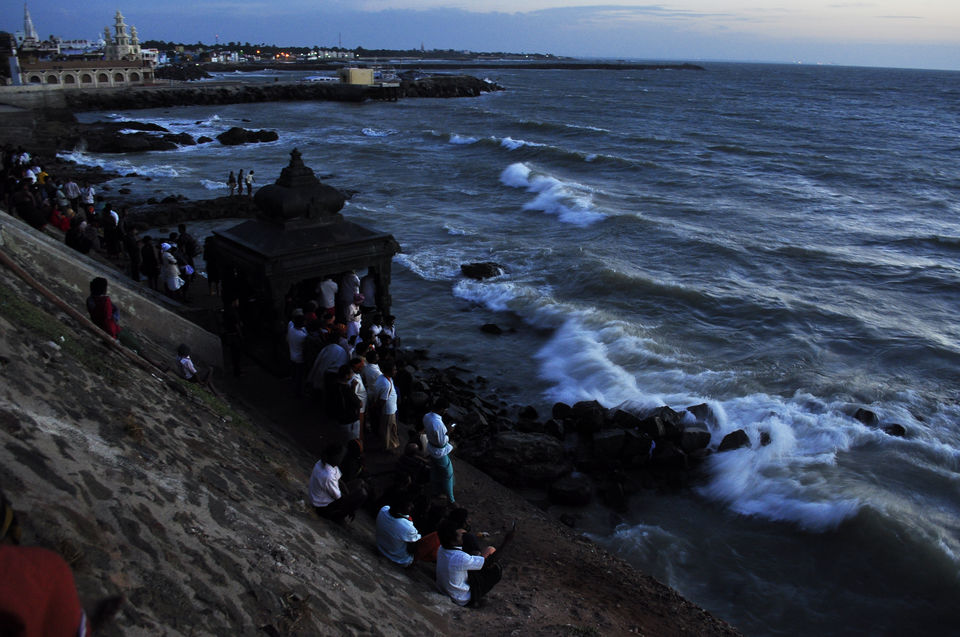





The wind blew in from every side. It was fighting with its own self, pushing and tugging at every object standing in its path of an incessant irritable desire to come together and slip away at every instance of time. The sky was a topaz blue with speckles of fluffy white patches of cloud, slowly arriving at the scene like a grand armada of the terrible kings of old. Waves upon waves of thunderous roar crashed on the rocks just below where we stood. The waters were at war too, with strains from the Bay of Bengal, the Arabian Sea and the Indian Ocean, coming together for the first time, testing the depths of their similarities and to maintain their individualistic traits of identities. So much so that their colours were distinct and the borders could be made out if one looked out, squinting through the continuous churn of sand, dust and water through the air. It was a border not made by man but by nature itself. The sun was slowly rising over the distant mammoth of Thiruvalluvar, dispelling darkness from the last tip of the mainland. The black canvas of an impetuous night was turning into the glorious dawn of unbridled excitement with more people adding to the bulging numbers of the faithful and the faithless and as the hour slowly approached, everyone lined along the walls at the edge to catch the first glimpse of the day’s light.
Welcome to Kanyakumari - the southernmost tip of Indian mainland, beyond which we see nothing save the endless expanse of the Indian Ocean. It’s a place steeped in divinity because of a young monk from Bengal who swam to a rock offshore and gained enlightenment in the late 1800s. But even as I stood at the hallowed grounds and stared far off at the horizon of nothingness save water, I could feel why Vivekananda might have felt the tug of a greater calling. It is a surreal experience to say the least, of standing on land and to see the last rocks vanishing in the water and to nothingness. To say I felt like a miniature would be grand. Through all the rush of the wind, and the feverish twists of the seas and the oceans, it seemed as if Nature was mocking us. What were we, if not for some puny existences in the bigger scheme of things? It is for us to only understand the part we play and the purpose we serve, not to seize the throne for ourselves and pretend to wield power over forces of which we know not.
The rock Vivekananda visited has come to be known by his name. It is a mere 5-10 mins journey by boat and one can see the lone outcrop from the mainland quite well. Yet, such was the will of the wind that morning; the ferry service was cancelled for the day, the authorities deeming the ride too dangerous. The rock now has a memorial building with monks staying there and also, a huge statue of the Tamil literary figure of Thiruvalluvar.
Sunrise in Kanyakumari is a feeling beyond words. As the light spread that morning, we noticed many small and narrow boats rowing out midway to the rock from all sides. It seemed as if a naval seize was underway in old world battles. We could not understand what they were doing and finally rested our belief on the simple fact that maybe they were just out fishing although, the tumultuous waters were hardly in the mood for yielding to any such manoeuvres. Our flimsy make belief was dashed quickly as we heard the crescendo of a thousand conch shells in unison at the exact hour of the sunrise. The rock created the perfect silhouette, the people in the boat stood up and clasped their hands in prayer and the sound of the conch shells continued. It was the surya-pranaam. What prayers were uttered by the boatmen or by the people around or by anyone on our side or on the rock, I know not. But I know of the momentous feeling of joy and extreme amazement I felt. It seemed the entire universe was the orchestra, rejoicing in the coming of the sun, for the sound was everywhere – to my left, to my right, to the top, to the bottom. It felt as if I was in an IMAX theatre, listening to the most soulful rendition of a prayer. The few minutes that passed were in a trance. I felt caught in a bubble, without a thought or action, rooted to the spot and listening with all my mind and body. The sand and rocks vibrated as the sound grew, yet was never deafening. And when the sun had fully risen, it subsided and the world’s volume slowly was turned on again for me.
The morning began its westward journey as the temple halls started their daily business. Bells started tolling at regular intervals and people started either lining up for the ferry (which was closed later without a single ride for the morning) or dipped themselves in the waters of the holy confluence. We made a vain attempt to reach Vivekananda rock but once the authorities thwarted such hopes, we satisfied ourselves by roaming around the place, getting kicked and punched by the wind that showed no sign of dying out. We looked out to the sea, to see the rock for the last time, before we headed back to Kovalam from where we had set out at the dead of the night. And we paid our last homage for the day, to Vivekananda, and to Nature.

